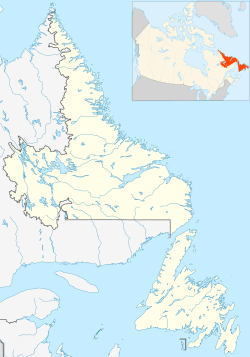Red Bay, Newfoundland and Labrador
| Red Bay | |
|---|---|
| Town | |

Red Bay seen from above
|
|
| Location of Red Bay in Newfoundland and Labrador | |
| Coordinates: 51°43′55″N 56°25′32″W / 51.73194°N 56.42556°W | |
| Country |
|
| Province |
|
| Region | NunatuKavut (unofficial) |
| Government | |
| • Type | Municipal incorporation |
| Area | |
| • Total | 1.58 km2 (0.61 sq mi) |
| Elevation | 10 m (30 ft) |
| Population (2006) | |
| • Total | 227 |
| • Density | 140/km2 (370/sq mi) |
| Time zone | Newfoundland Time (UTC-3:30) |
| • Summer (DST) | Newfoundland Daylight (UTC-2:30) |
| Area code(s) | 709 |
| Official name | Red Bay Basque Whaling Station |
| Type | Cultural |
| Criteria | iii, vi |
| Designated | 2013 (37th session) |
| Reference no. | 1412 |
| State Party | Canada |
| Region | Europe and North America |
| Official name | Red Bay National Historic Site of Canada |
| Designated | 1979 |
Red Bay is a fishing village and former site of several Basque whaling stations on the southern coast of Labrador in the Province of Newfoundland and Labrador, Canada. Between 1530 and the early 17th century, Red Bay was a major Basque whaling area. The site is home to three Basque whaling galleons and four small chalupas used in the capture of whales. The discovery of these vessels makes Red Bay one of the most precious underwater archaeological sites in the Americas. Since June 2013 it is a UNESCO World Heritage Site.
Red Bay is a natural harbour residing in the bay that gives it its name, both names in reference to the red granite cliffs of the region. Because of the sheltered harbour it was used during World War II as a mooring site for naval vessels. In the bay are Penney Island and Saddle Island, which were used by the Basques for their whaling operations. The location of the sunken vessel San Juan is near Saddle Island.
Between 1550 and the early 17th century, Red Bay, known as Balea Baya (Whale Bay), was a centre for Basque whaling operations. Sailors from southern France and northern Spain sent 15 whaleships and 600 men a season to the remote outpost on the Strait of Belle Isle to try to catch the right whale and bowhead whales that populated the waters there, according to Memorial University of Newfoundland.
In 1565, a ship—believed to be San Juan—sank in the waters off Red Bay during a storm. Other, smaller vessels, such as chalupas, have also been recovered from the waters.
...
Wikipedia


